The CMStorm Stryker -
Cooler Master has been making from impressive cases for a while now. This started back when they decided to pay more attention to for as a condition of function instead of just trying to make them look flashy. It was an important lesson for Cooler Master as they worked to get the very fickle gamer and enthusiast market to notice them. With the Stryker the first thing you see is the glossy white of the main portion of the case in stark contrast to the black grills. Cooler Master decided to use a combination of plastic and metal to achieve this look. The sheet metal pieces are coated with high-gloss white enamel so they match the look of the glossy plastic pieces. I it is a very clean look. Interestingly enough the front reminds us of the original Thermaltake Armor at first glance although the Stryker does not open up like the Armor did so the impression is very minimal.
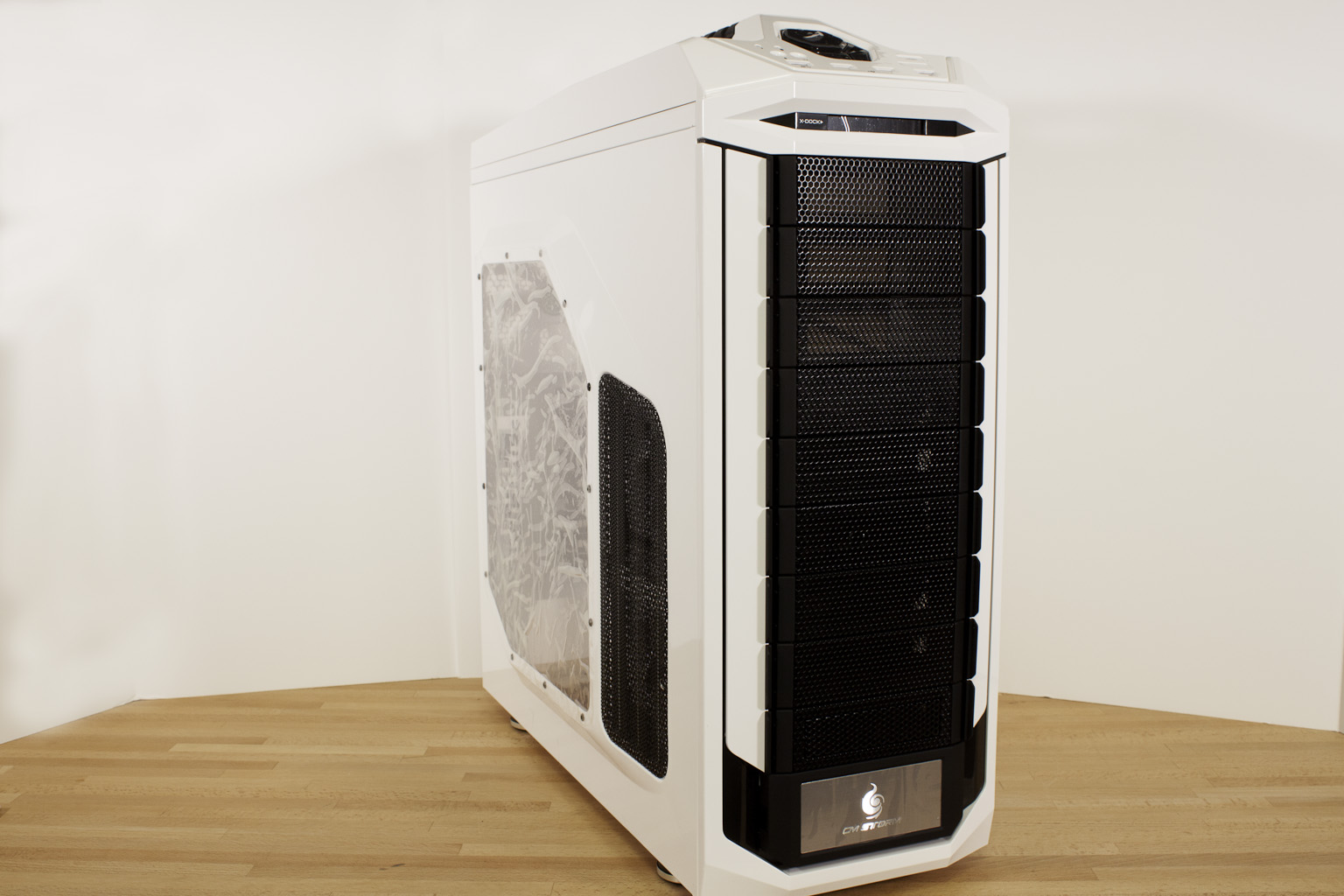 |
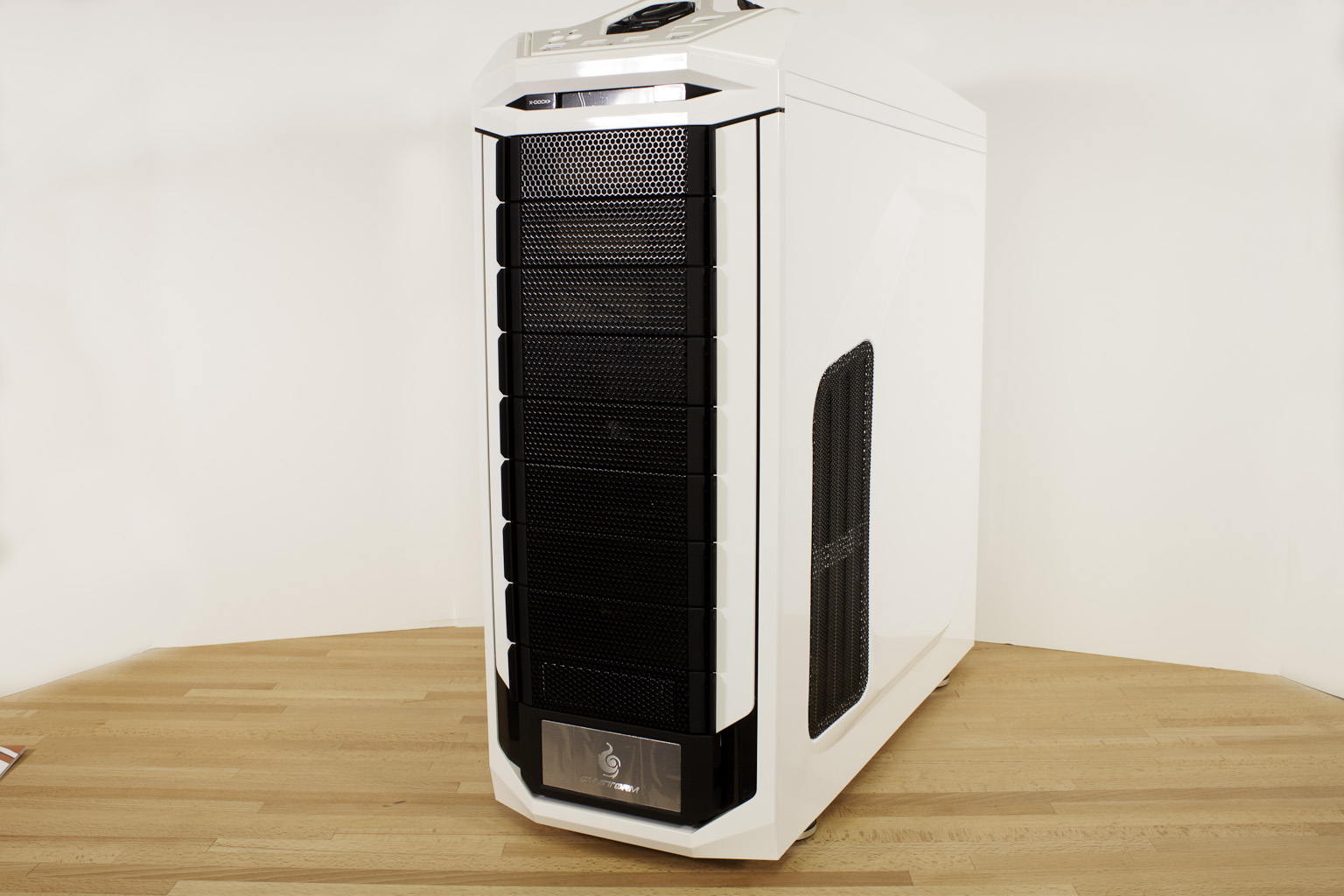 |
The front of the Stryker features nine 5.25 bays. More than half of these are occupied with two 3.5-inch drive cages which we will talk about in a minute. One of the bay covers has a cut out for a 3.5-inch drive. We are not sure if this was meant for a breakout box, additional front panel headers or just for anyone still using a floppy or Zip drive. It is nice of Cooler Master to toss this in though. At the bottom of the case there is a large CMStorm logo, behind this is a try to keep all of your mounting hardware.
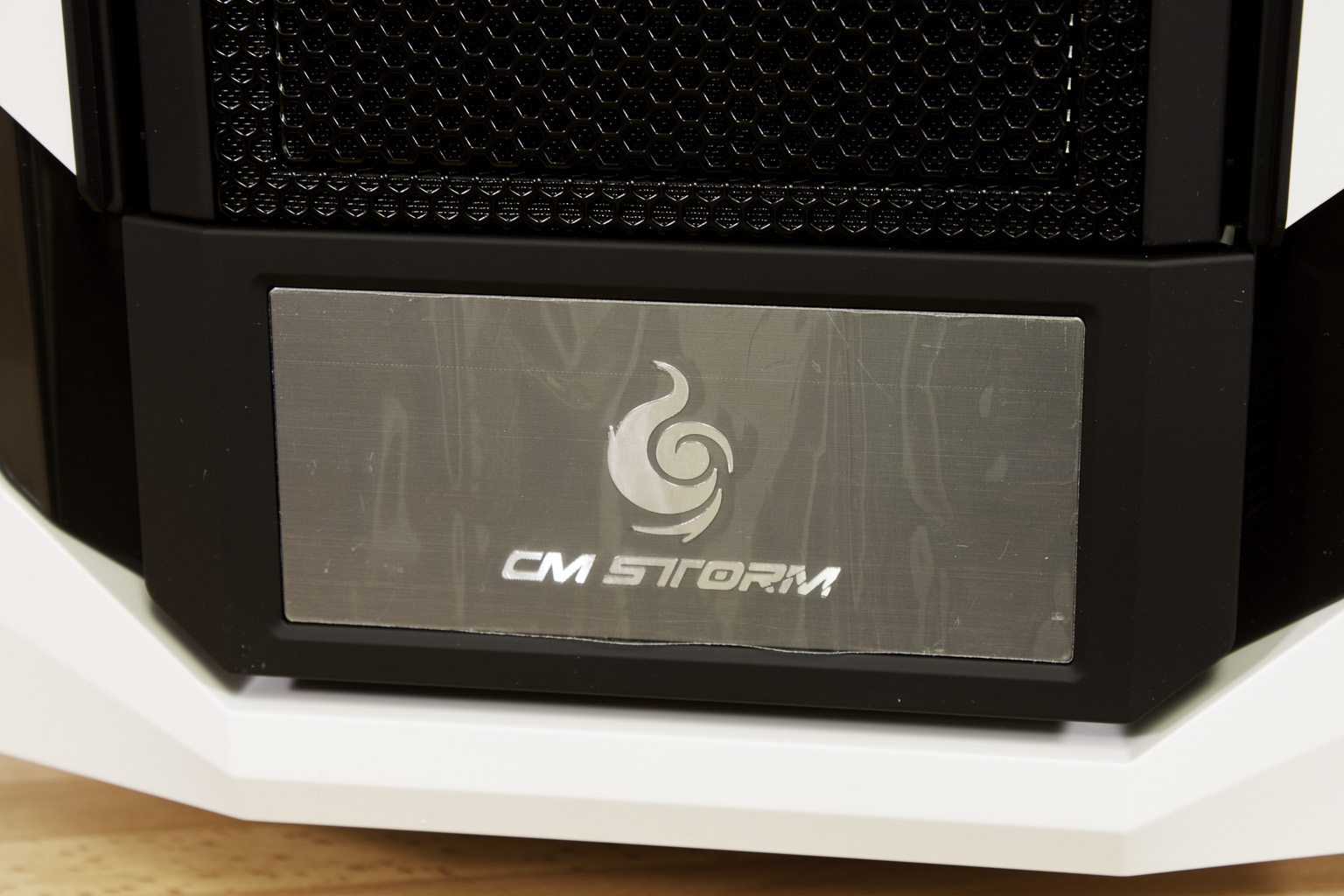 |
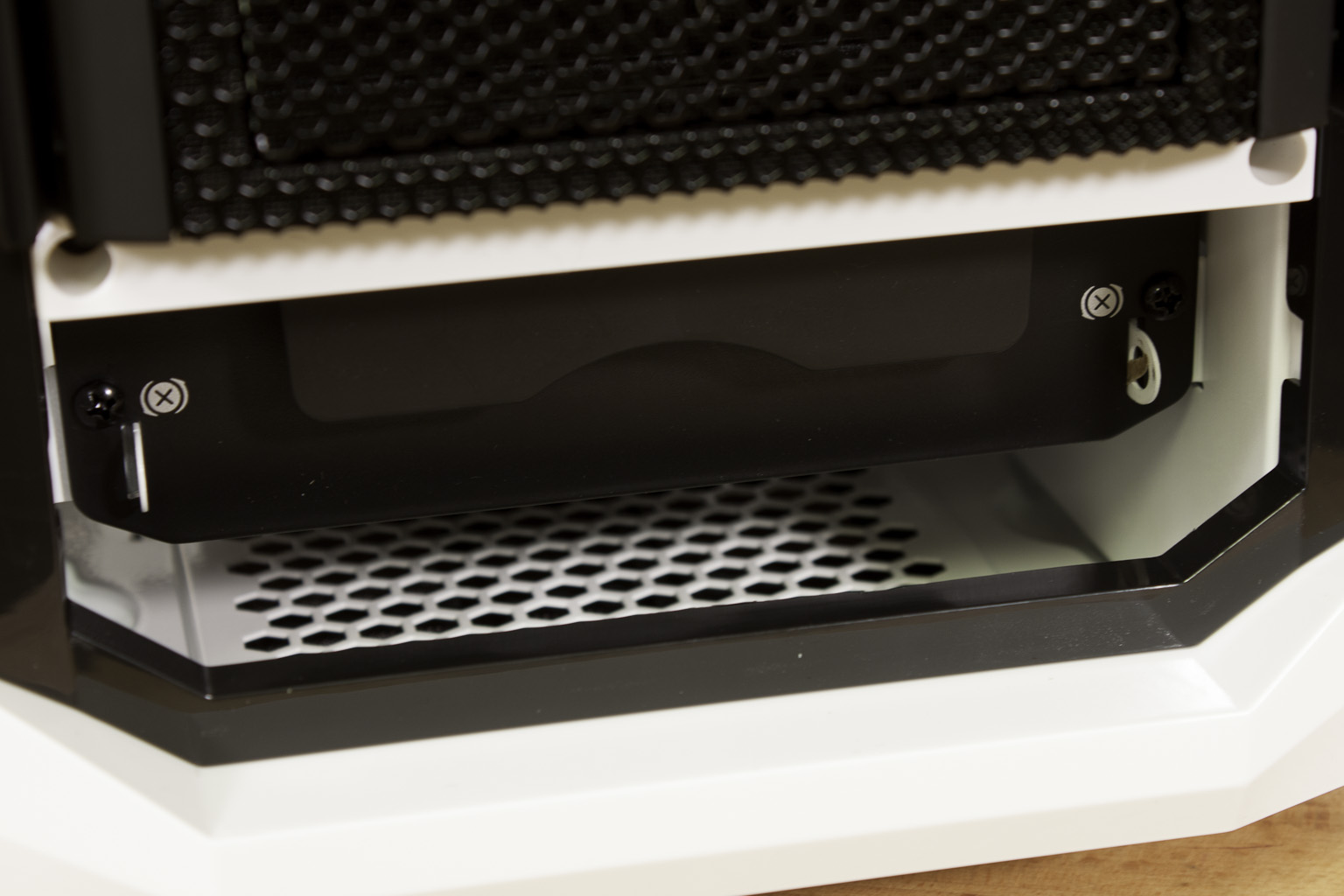 |
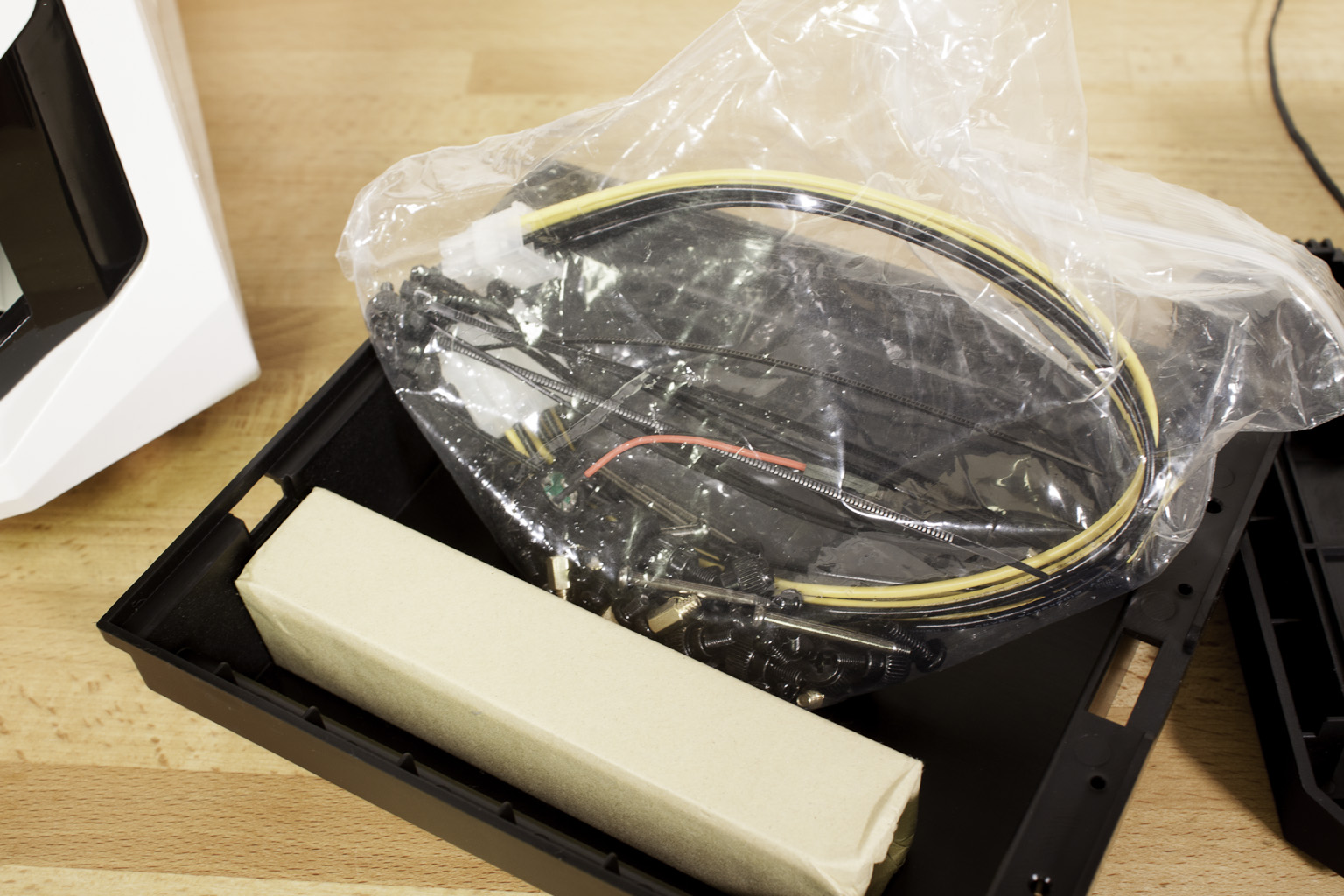 |
 |
The tray is held in place by two small screws and has a lid to make sure nothing falls out. When you first open the tray you will find some of the accessories we talked about earlier. One of these is a great idea on the part of Cooler Master, an 8-pin ATX Aux extension cable. We know we commonly recommend getting one of these for use with motherboards. This inclusion will make installation of even the most cramped motherboard a little easier. You also get a few Zip-Ties for cable management and a set of rails for installing a 3.5-inch drive in one of the 5.25-inch bays.
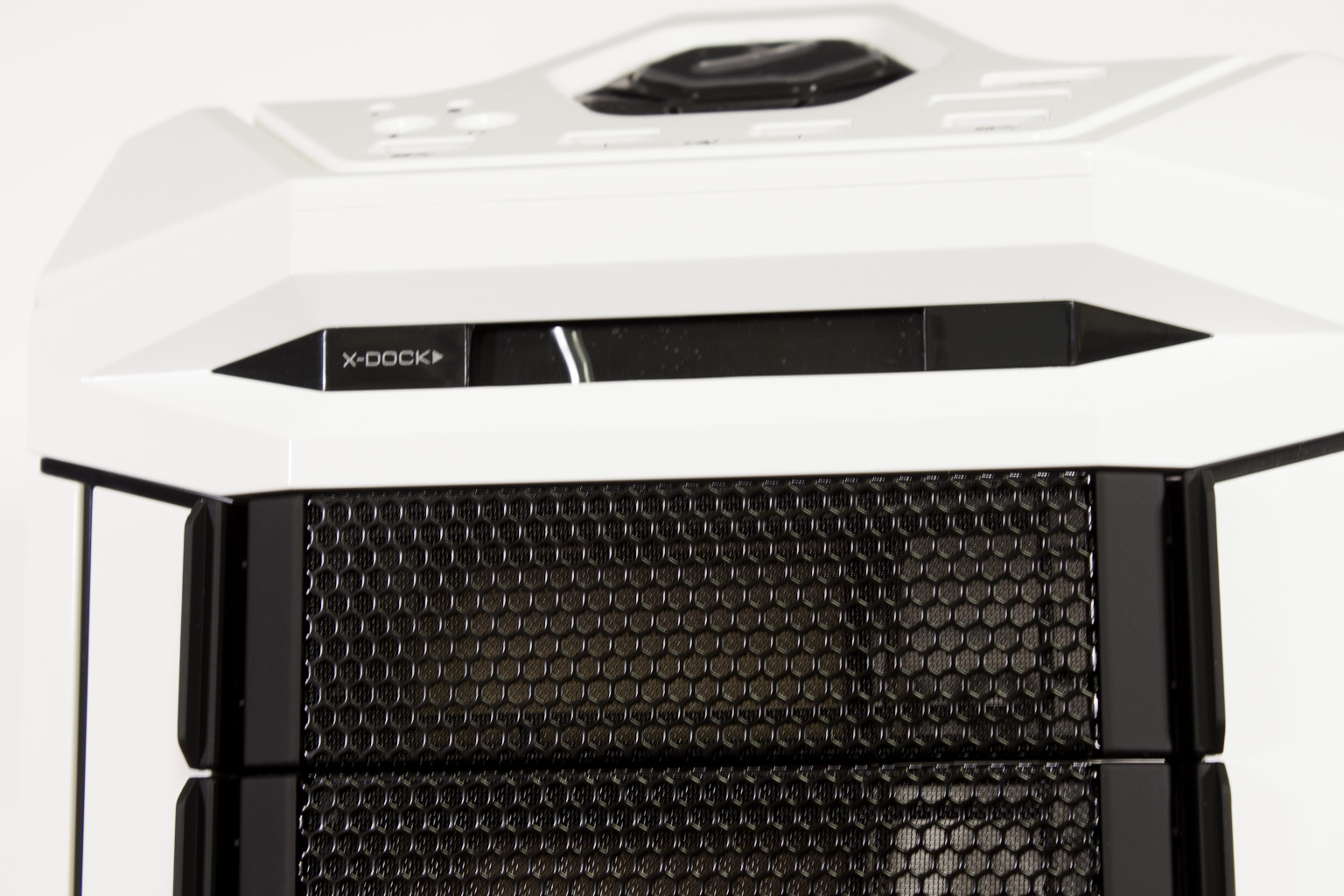 |
 |
Moving from the bottom to the top we find another nice touch from Cooler Master called the X-DOCK. This handy little slot is the perfect size for a 2.5-inch SSD. It is a neat feature, but we wonder about its real functionality. Considering the cost of SSDs we doubt anyone would buy one just for backup and it is unlikely that you would need or want to swap out a drive that you might use for caching. Where it might work out is if you used this slot as the primary boot slot. You would be able to quickly swap out operating systems to keep things interesting. It might make a mess of any storage drives you have if they are not formatted with a file system that is compatible across all of the operating systems you would be using though. Still it is a feature that does have potential.
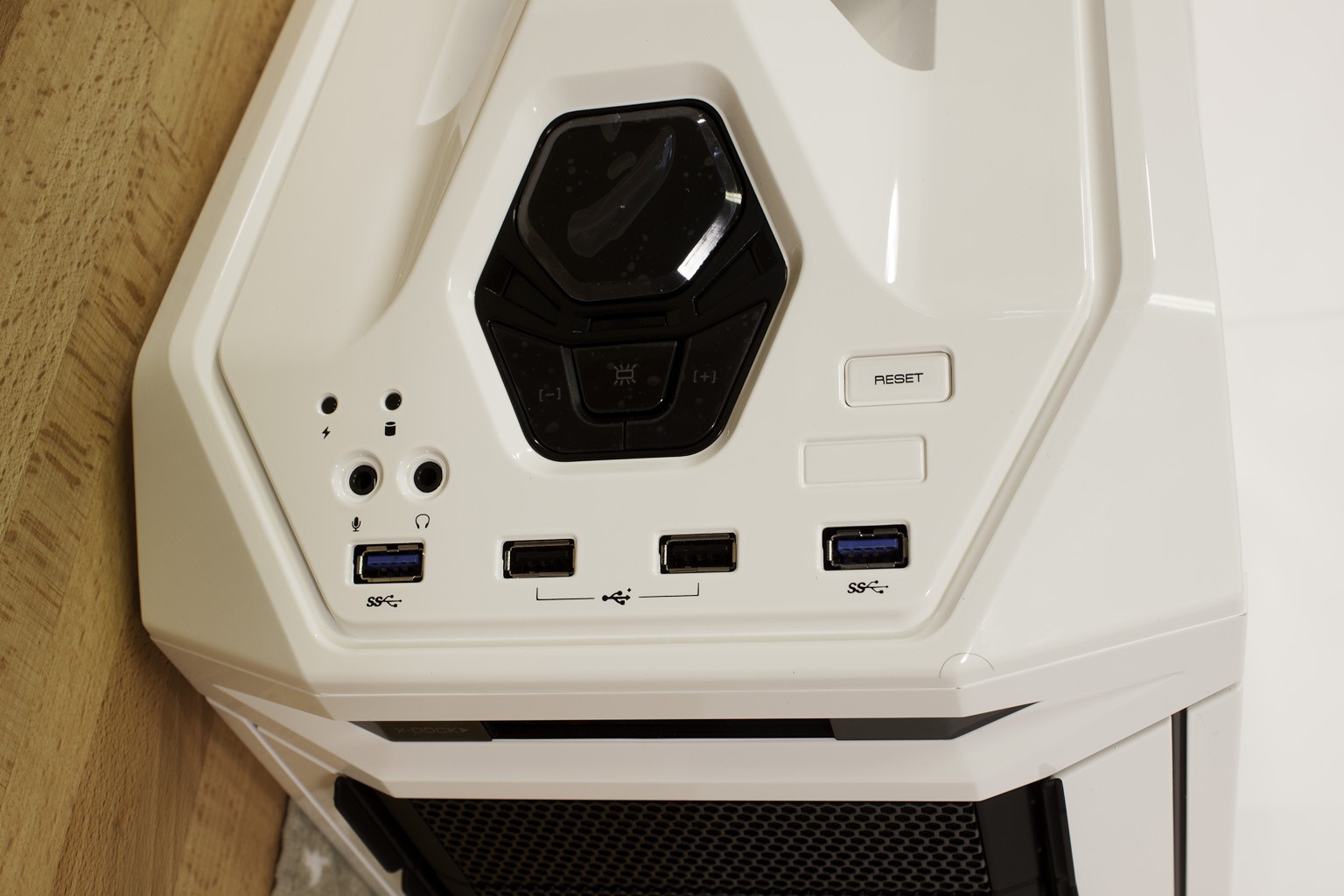 |
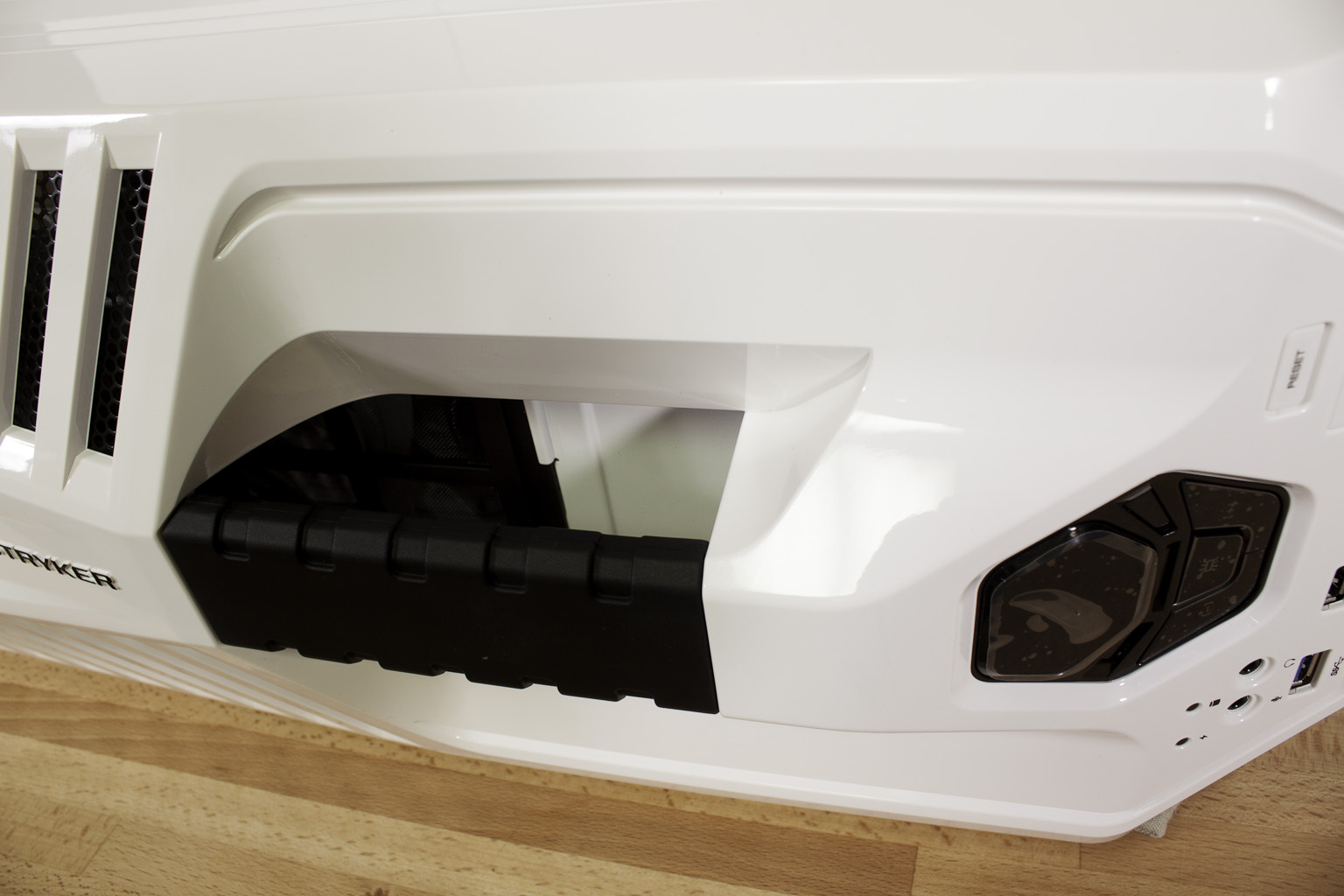 |
Moving up onto the top of the Stryker we come to the front panel and the controls (we apologize for the perspective). The layout of controls and front panel options are very nice. Cooler Master has arranged the USB ports far enough away from each other that you will not have an issue plugging in multiple devices. This is something that has been an issue with other cases in the past where they try to group the ports to save space. It meant that if your USB device was too big you lost out on the other ports. This is not going to happen with this case though.
The activity lights and audio out ports are also well spaced and located far away from the reset button. This makes accidentally restarting your system when plugging something in less likely. The Power Button is a large pentagonal button which lights up with the CMStorm logo when powered on. There are also three red LEDs below the power button. These LEDs tell you the speed of the fans inside the case. When all three are lit up you are at max speed for the fans. If there is one LED lit then you are at minimum fan speed. The button in the center turns the fan LEDs on and off. In keeping with the white theme of the Stryker the fan LEDs are also white.
Moving back from the control panel we find the carrying handle. Now, we want to start off by stating that you are not very likely to carry the Stryker with you at all once you see what it is best at. The handle on the CMStorm Stryker is very nice (not that we think you will use it). It has a rubberized grip complete with s cushion under it for your fingers. It allows you to get a good grip even when the Stryker is full of goodies. Behind the handle are vent holes for airflow out of the top of the Stryker (there is a 220mm fan under there too).
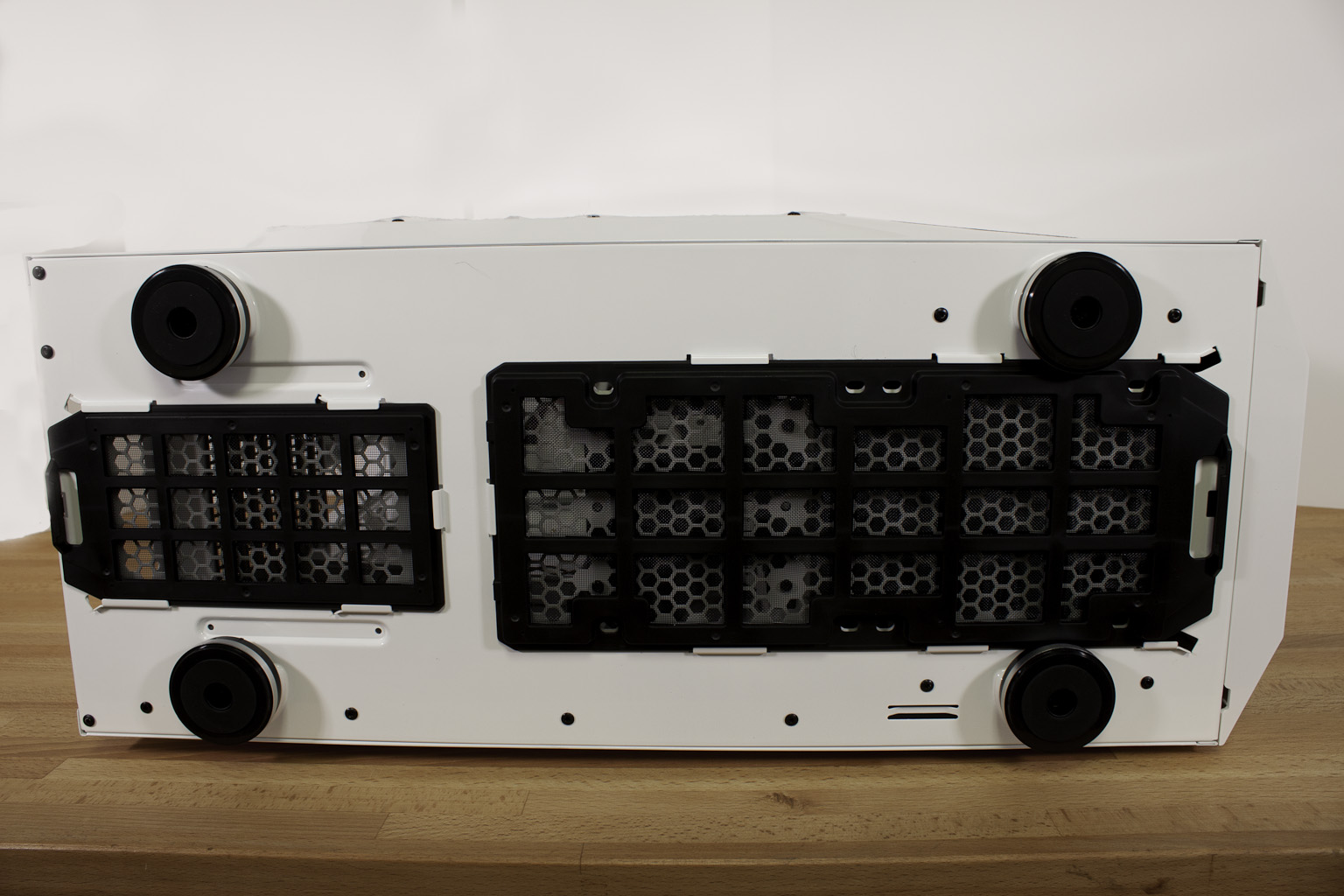 |
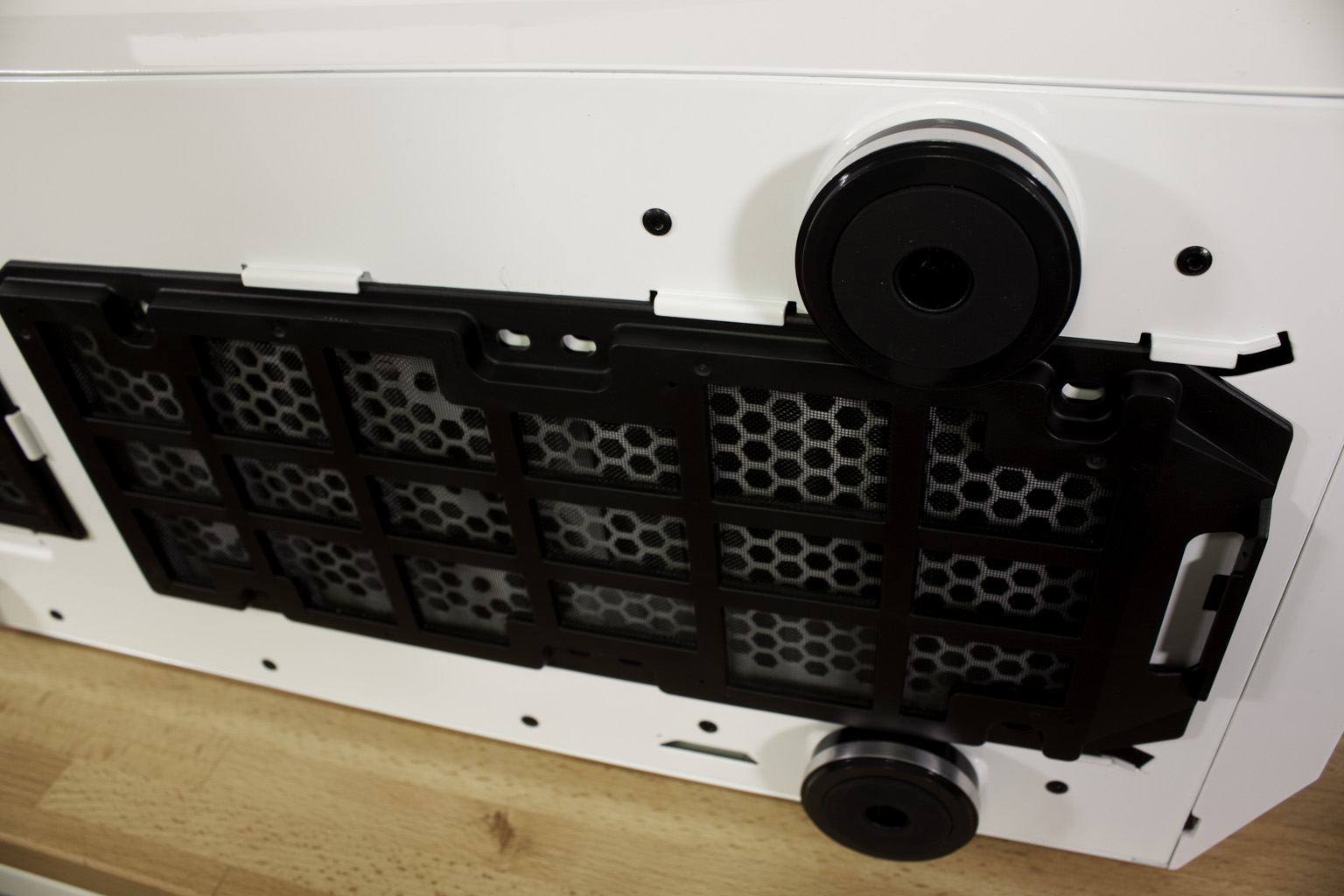 |
Flipping the Stryker over we get a good look at the bottom of the case and the filters Cooler Master put into help reduce the amount of dust that gets into a typical system. Both of these filters can be removed, but can be problematic since you have to pull them down to unlock them. When the case is on the feet there is not much room to get your fingers in and still pull these down far enough to get them out. The front vent area is very long and looks like it would work with great a radiator. To use a radiator in this area you would also have to remove the accessory box from the case.
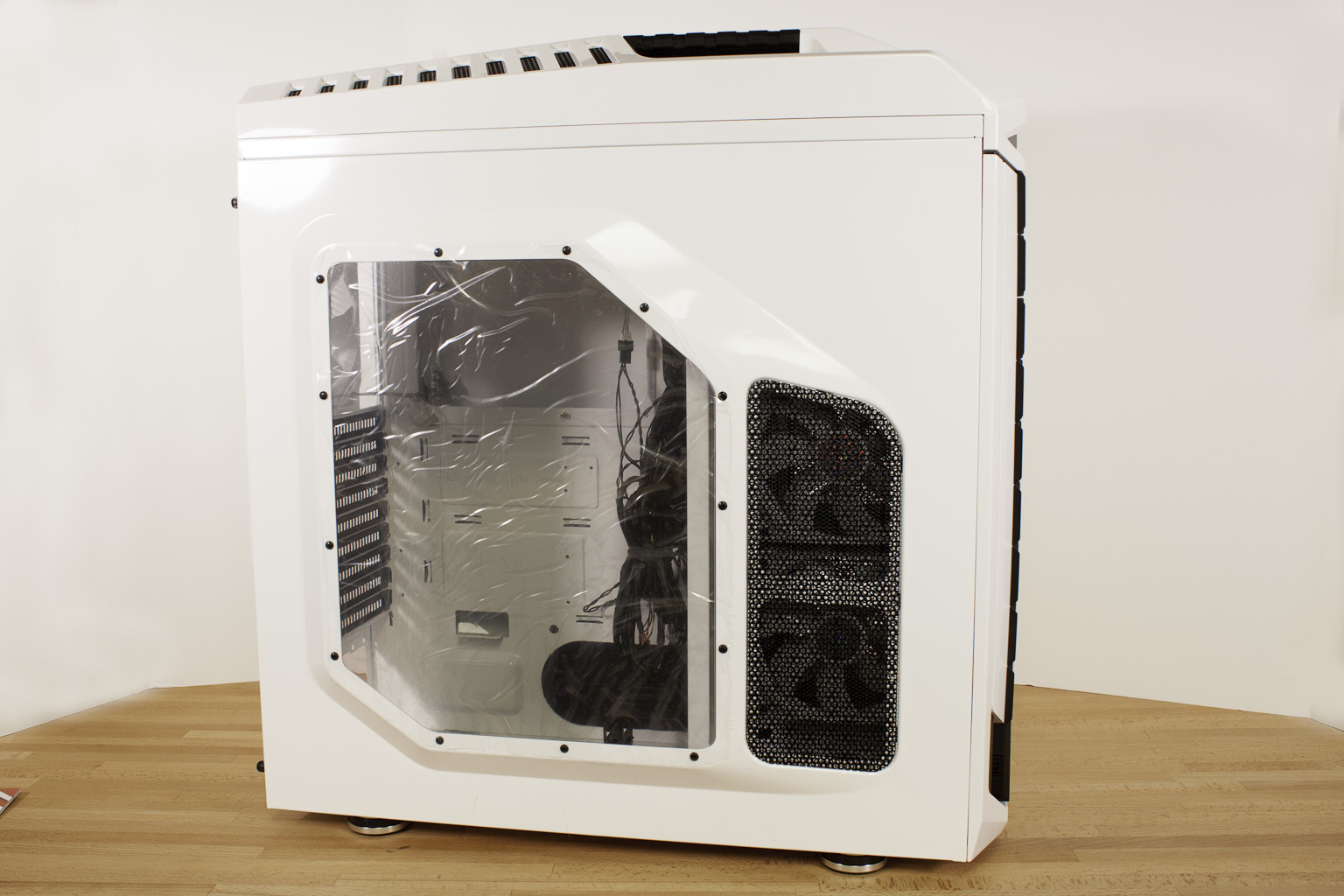 |
 |
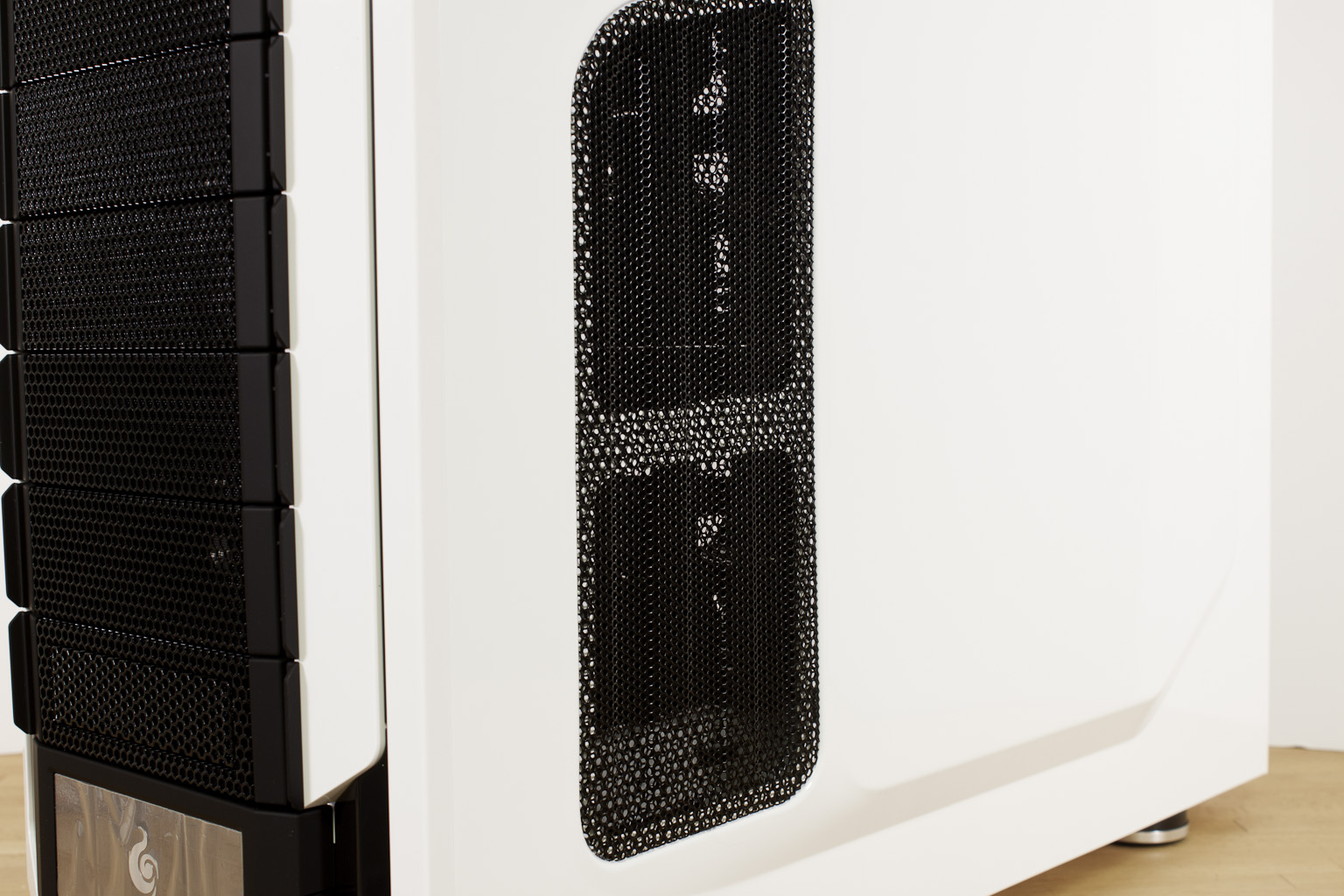 |
Picking the Stryker back up and looking at the left side of the case we find an air grill and also the side window panel. Both of these are pushed out from the main lines of the Stryker to allow for more room inside the case (for larger air cooler and to help prevent hotspots). The side window is rather large and gives you are nice look at any system you build into it, but is also designed to hide some of the less ingesting details and areas where you might have clutter. The right side of the case is identical to the left with the exception of the window; here the extruded part of the case is to give you more room to hide cables that you do not want everyone to see.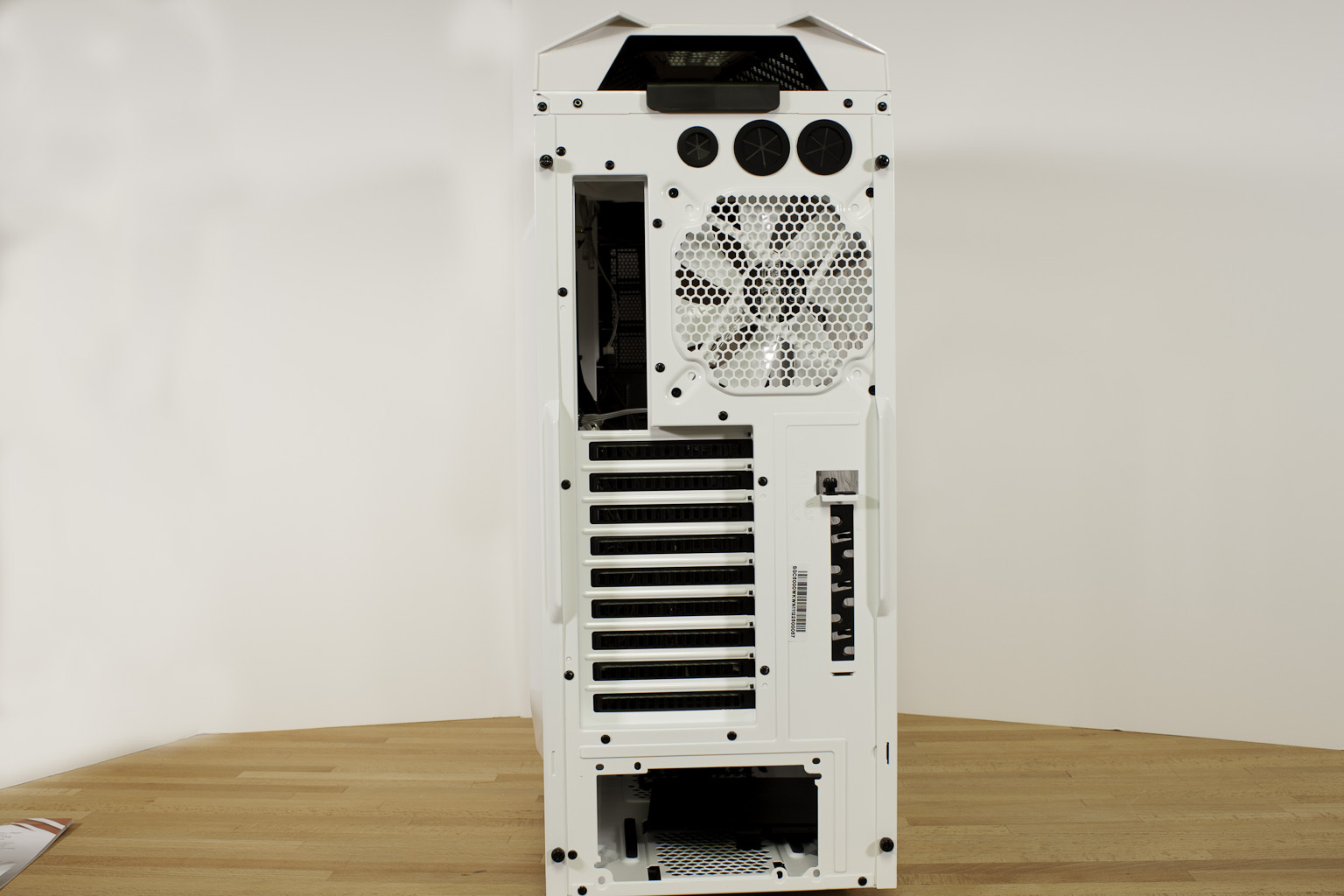
Moving around to the back of the Stryker things look pretty normal. You have a spot of your PSU at the bottom which is supposed to help with cooling. Cooler master has also given you a larger than normal number of peripheral slots (nine total) which gives you plenty of room for three-way and even Quad SLI/Crossfire X systems. Cooler Master has also included their popular extra slot for any rear peripheral devices (like extra USB or SATA ports). This slot can come in handy for making sure you do not run out of space because of wanting to use some of those headers on your motherboard. Toward the top of the back side of the case we find the typical rear exhaust fan and three openings for external water cooling (or an external reservoir).
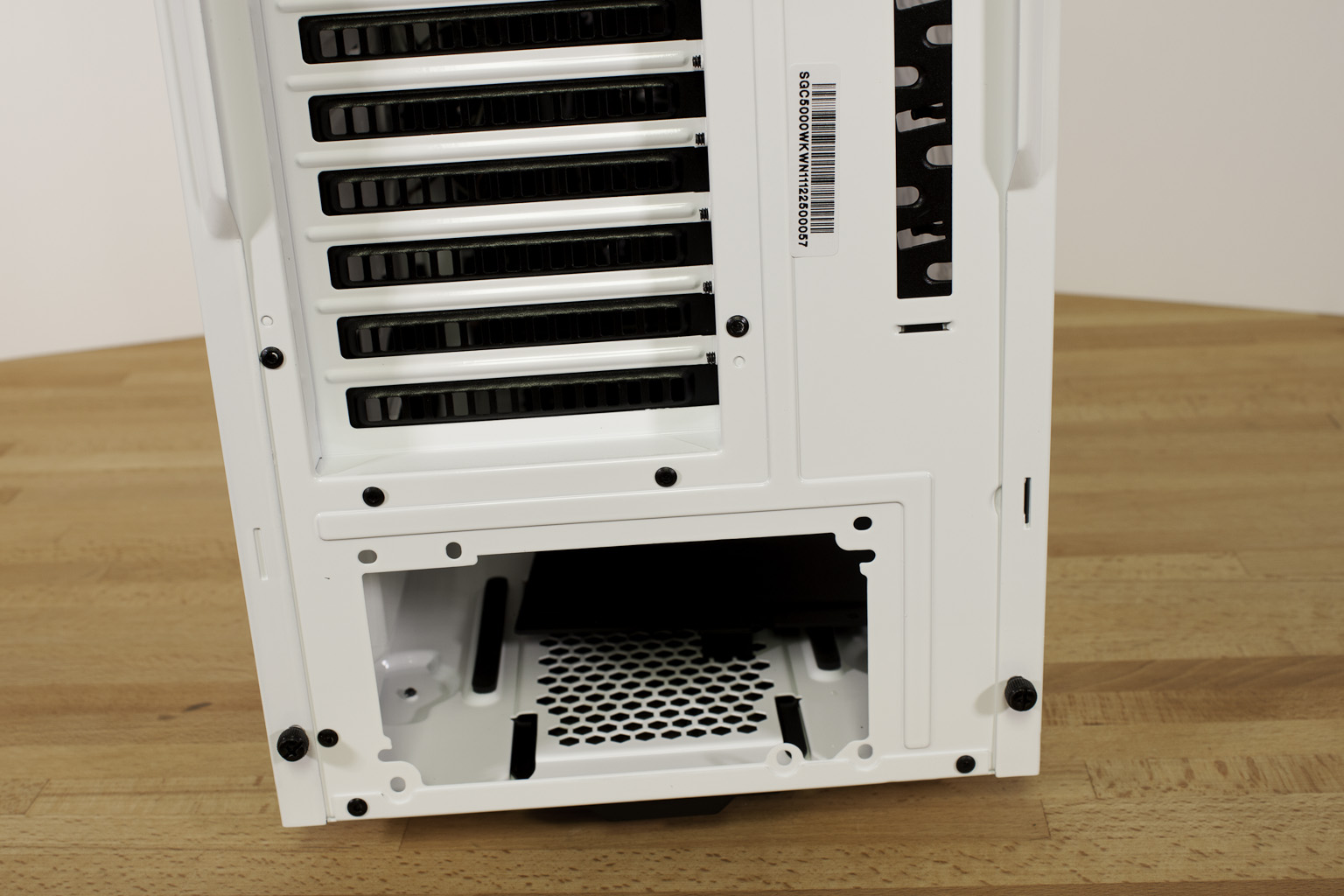 |
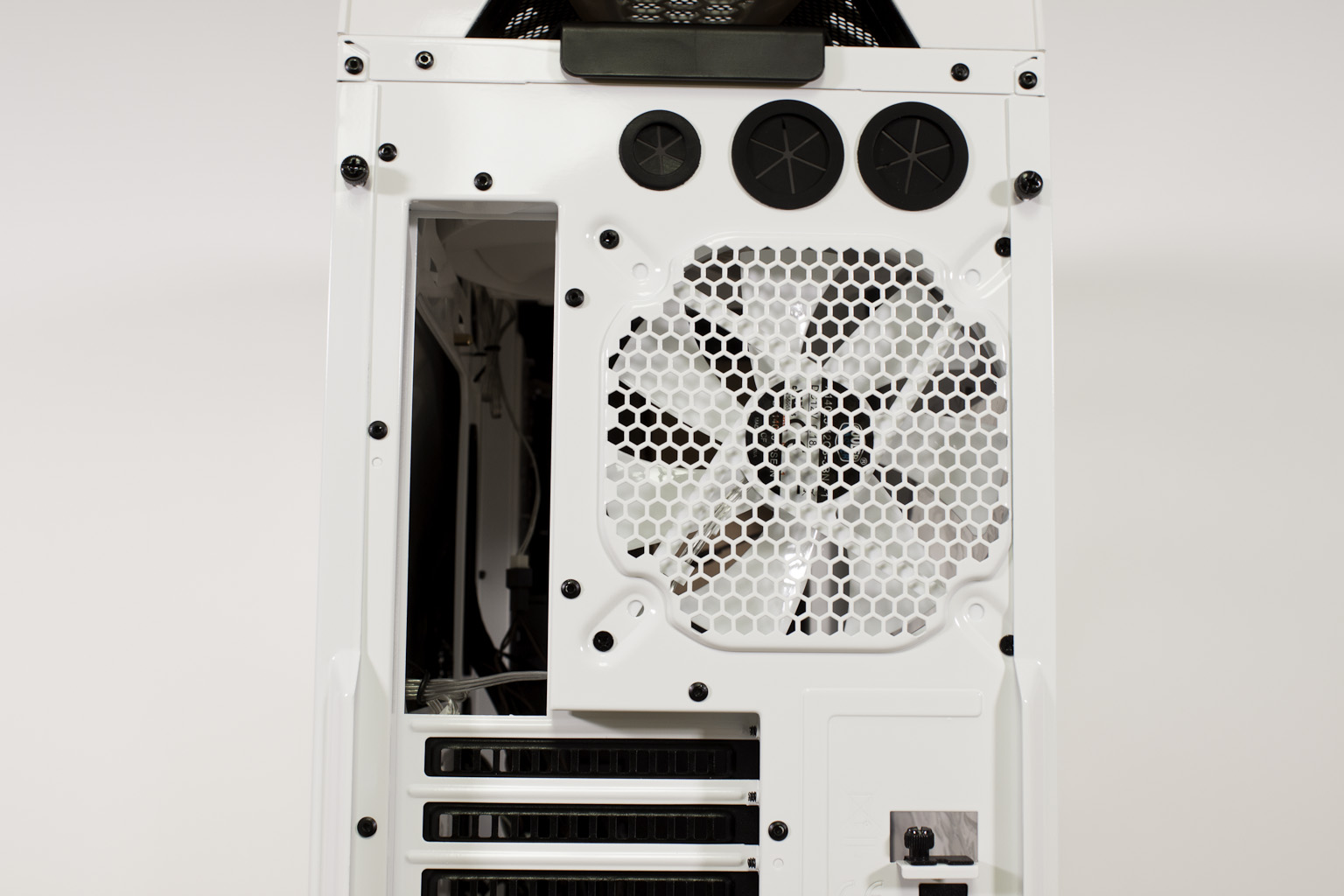 |

In this shot you can see inside the ridge at the top of the Stryker and also get a glimpse of the filter that covers the top and prevents dust from getting into the system from this side.
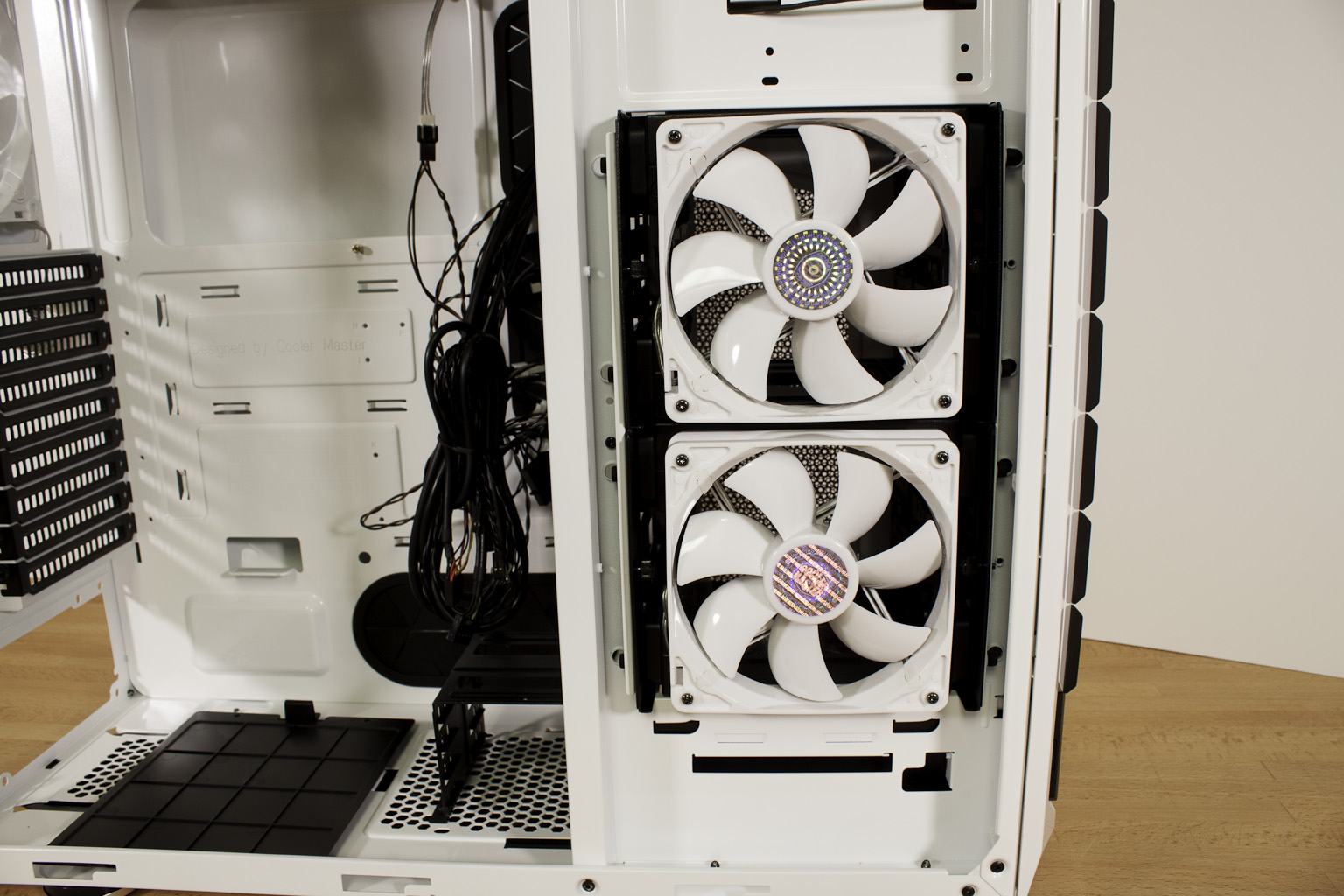 |
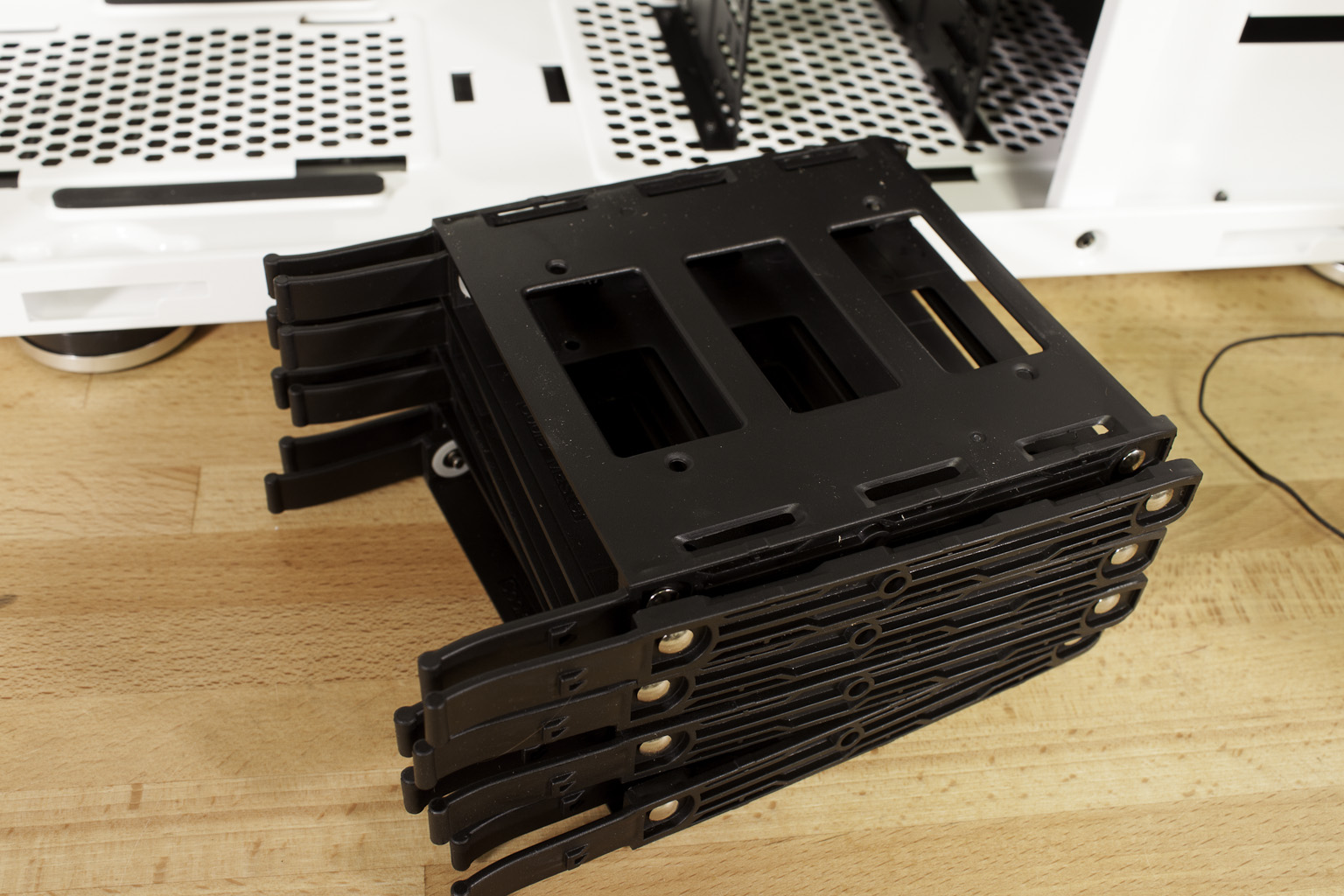 |
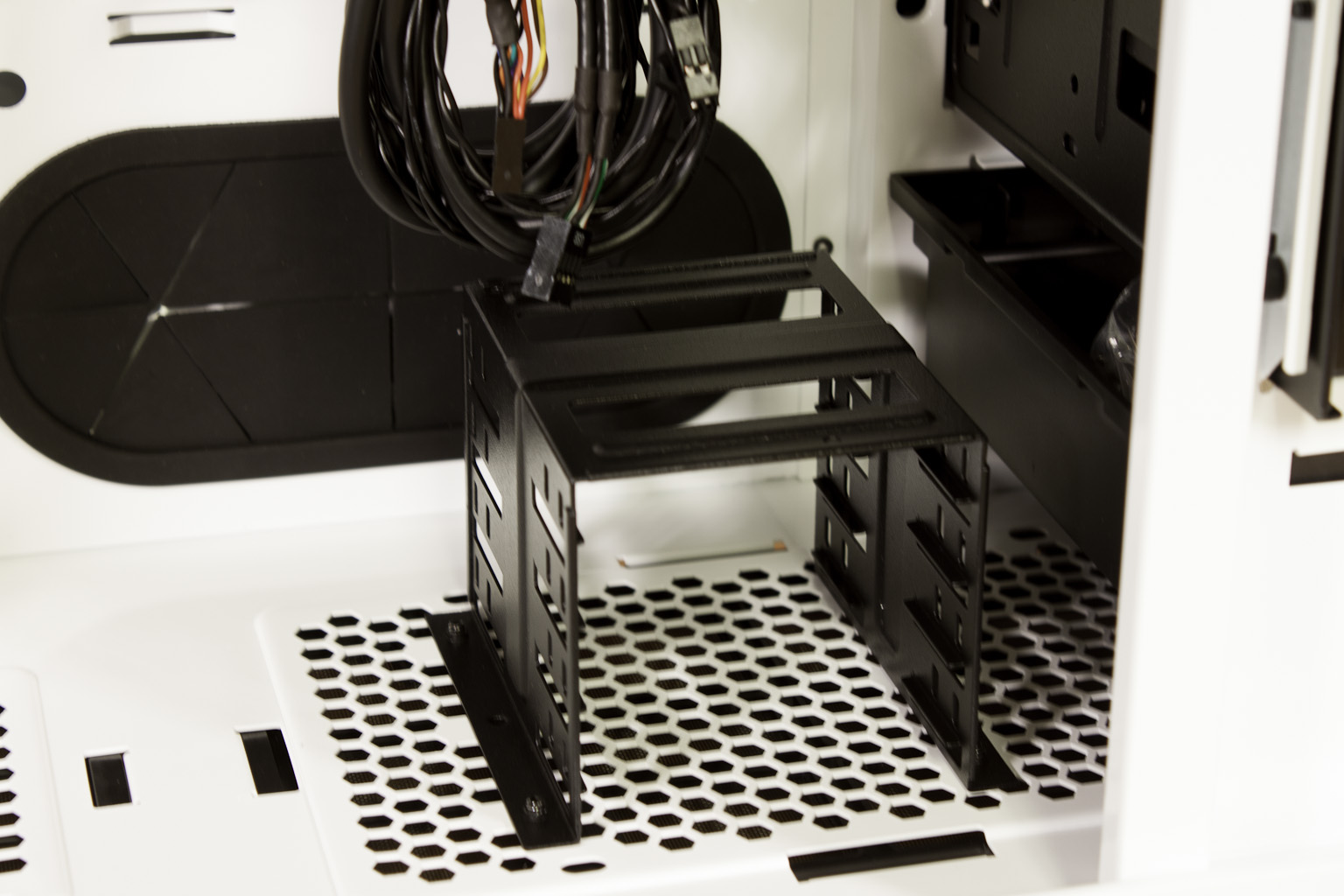 |
After removing the left side panel we can get a good look inside the Stryker and see what Cooler Master has set up for us. The first thing you might notice are the two 120mm fans, these are on the front of the two HDD cages that can also be rotated for either side or front access. Each cage can fit up to four 3.5 or 2.5-inch HDDs giving you immediate room for 8 drives. You can also remove the cages if you want to use them for 5.25-inch optical drives. Cooler master has provided 8 trays that make installation and removal of these drives much easier. You can also see that Cooler Master has left large openings in the backplane of the case. This allows for the easy installation/removal of larger coolers that require a mounting bracket on the back of the motherboard.
In addition to the 8 slots for 3.5/2.5-inch drives the Stryker has a small cage for four additional 2.5-Inch SSDs. When you add this to the X-Drive at the top you could stack this up with as many as 13 drives. That is a lot of storage to be sure. One thing to note here, if you are planning to use this area for your reservoir you will also need to remove this cage as you might if you use a very large PSU. You will still have plenty of room for drives even with this cage out, so it is not a major loss.
Behind the 2.5-inch cage you can see a pass through with a rubber grommet; this is meant to pass the cables from your PSU through to the back side of the motherboard tray. This will help you keep a clean case and also improve air flow.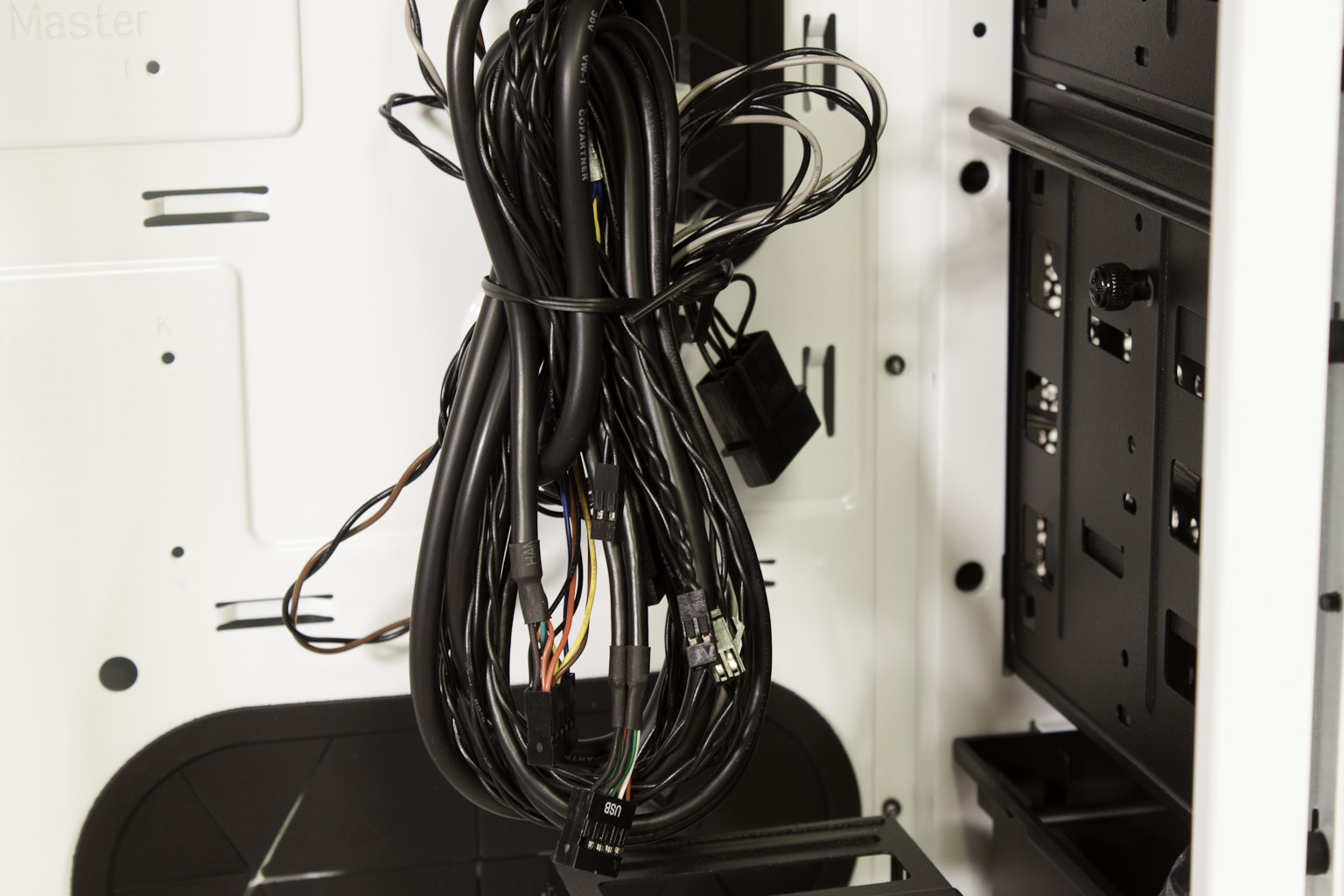
This mass of cables is made up of front panel controls, USB cables, audio, and also fan lights and power. The way it comes right out of the box is very messy but with a few zip-ties and some braiding you can get everything cleaned up and behind the MB tray where it is out of site. To help you keep things even cleaner there are a few openings through the back plane in the Stryker. These will let you pass the cables that are needed while keeping the rest out of the way. One downside to the Stryker which surprised us was the need to use screws to mount your 5.25-inch drives. We would have thought Cooler Master would want to keep with the tool-less designs they have been using, but that was not the case here.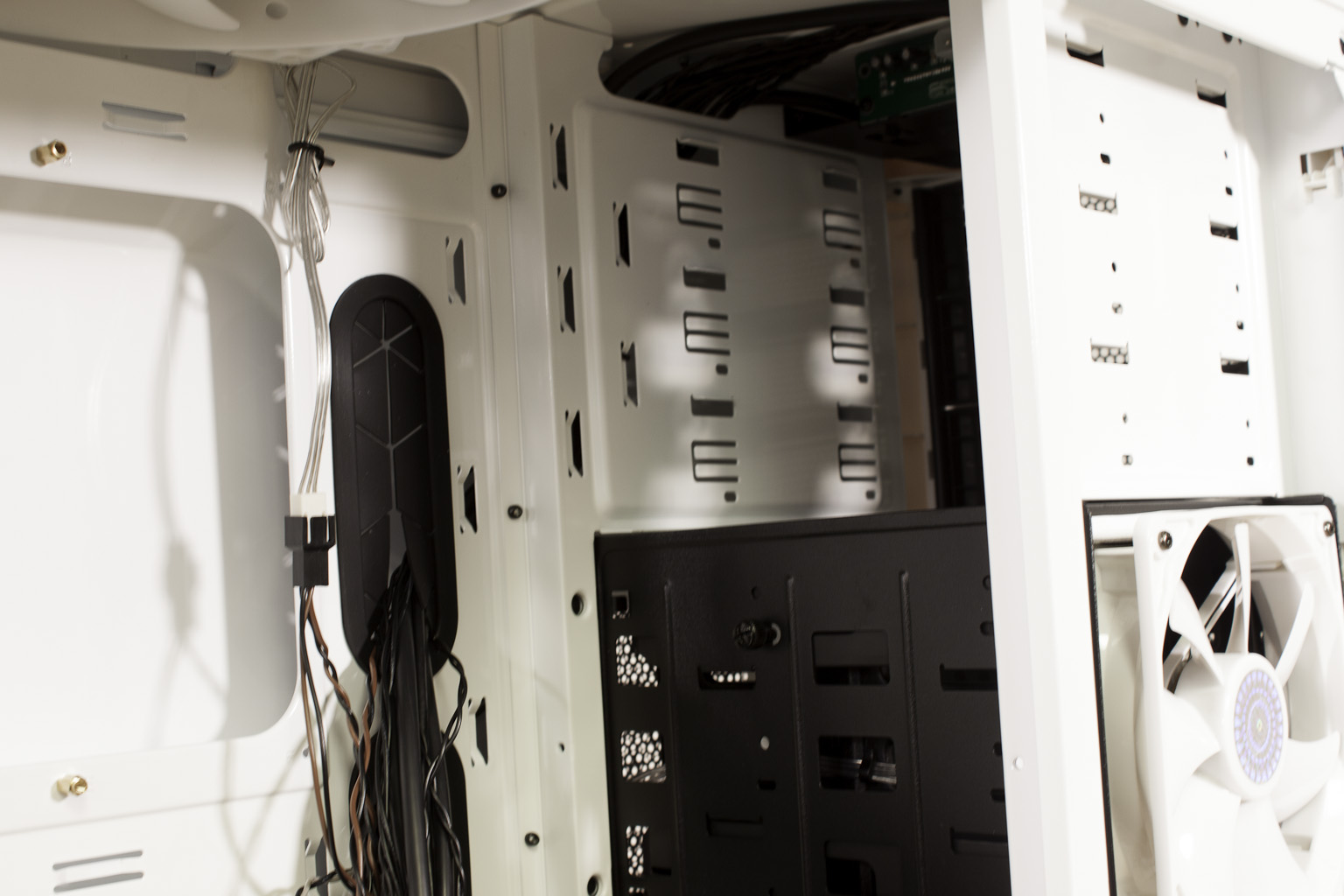
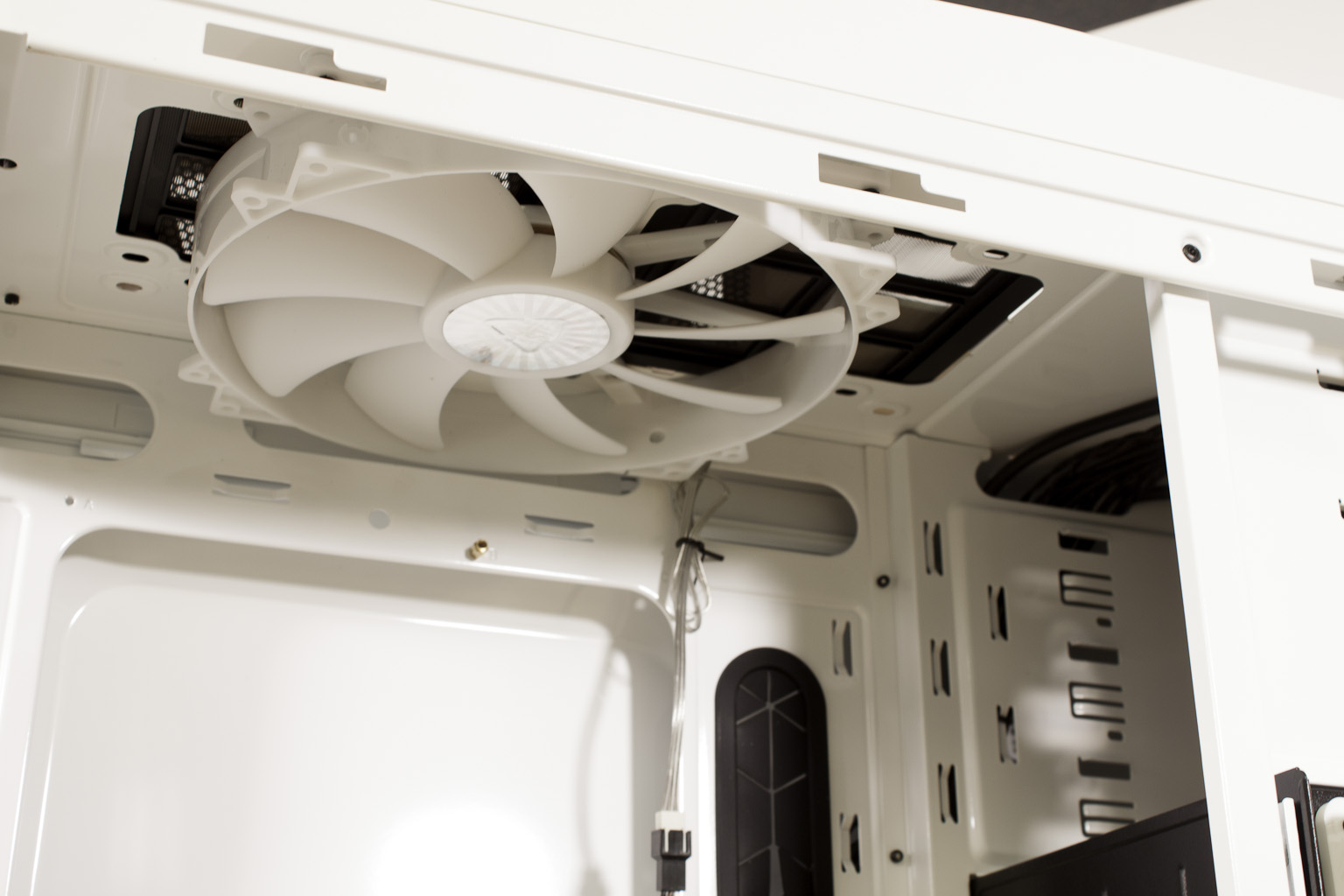
In our final shot inside you can see the 220mm fan in the top of the case. This fan can be removed and replaces by a larger radiator for water cooling. We have to say that the overall design of the Stryker is very nice with more options that many people will know what to do with. Cooler Master has made sure that there is something for almost everyone with the Stryker. Below are two shots of trhe Stryker as we saw it at CES 2012... it is interesting to see what the final product looks like.
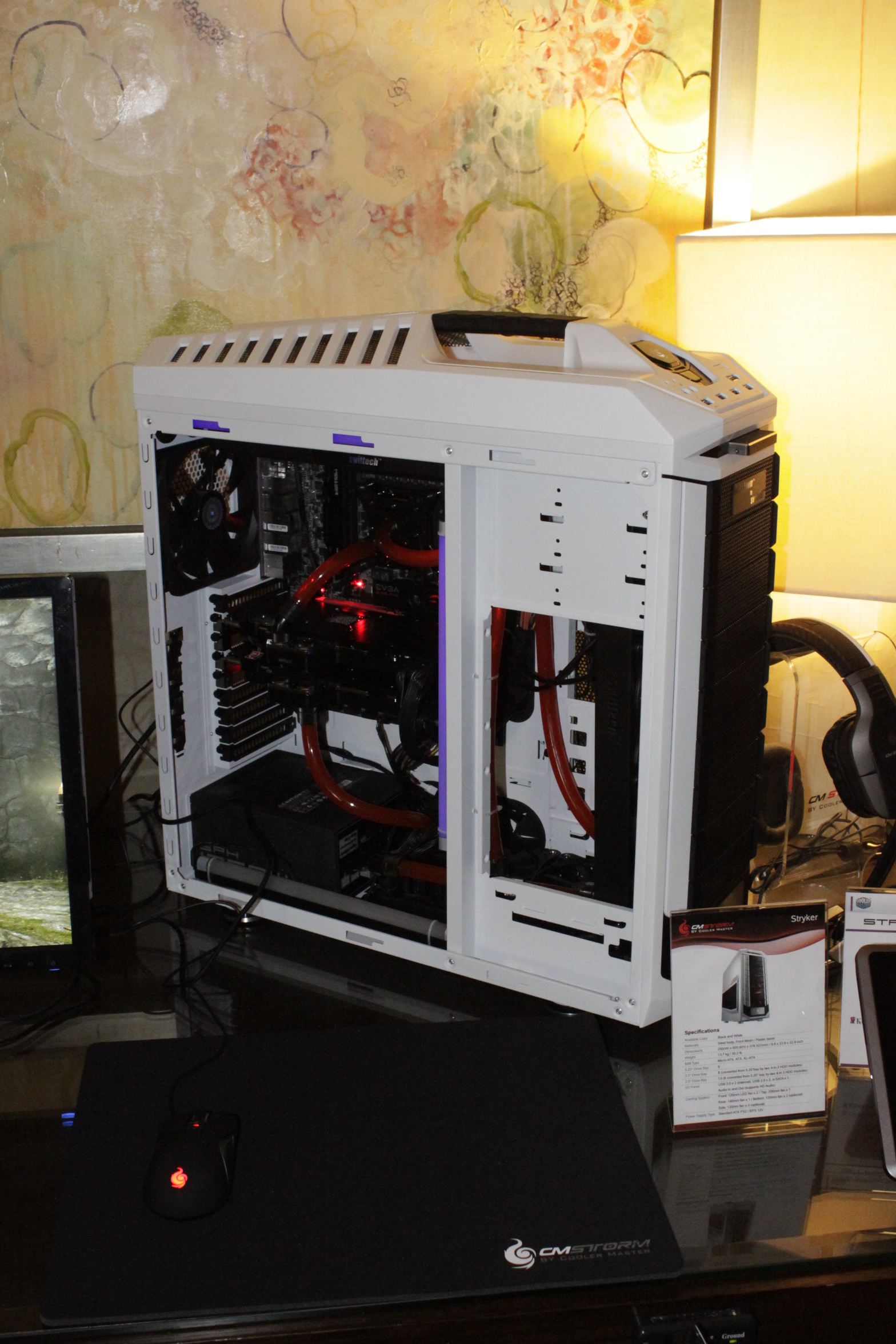 |
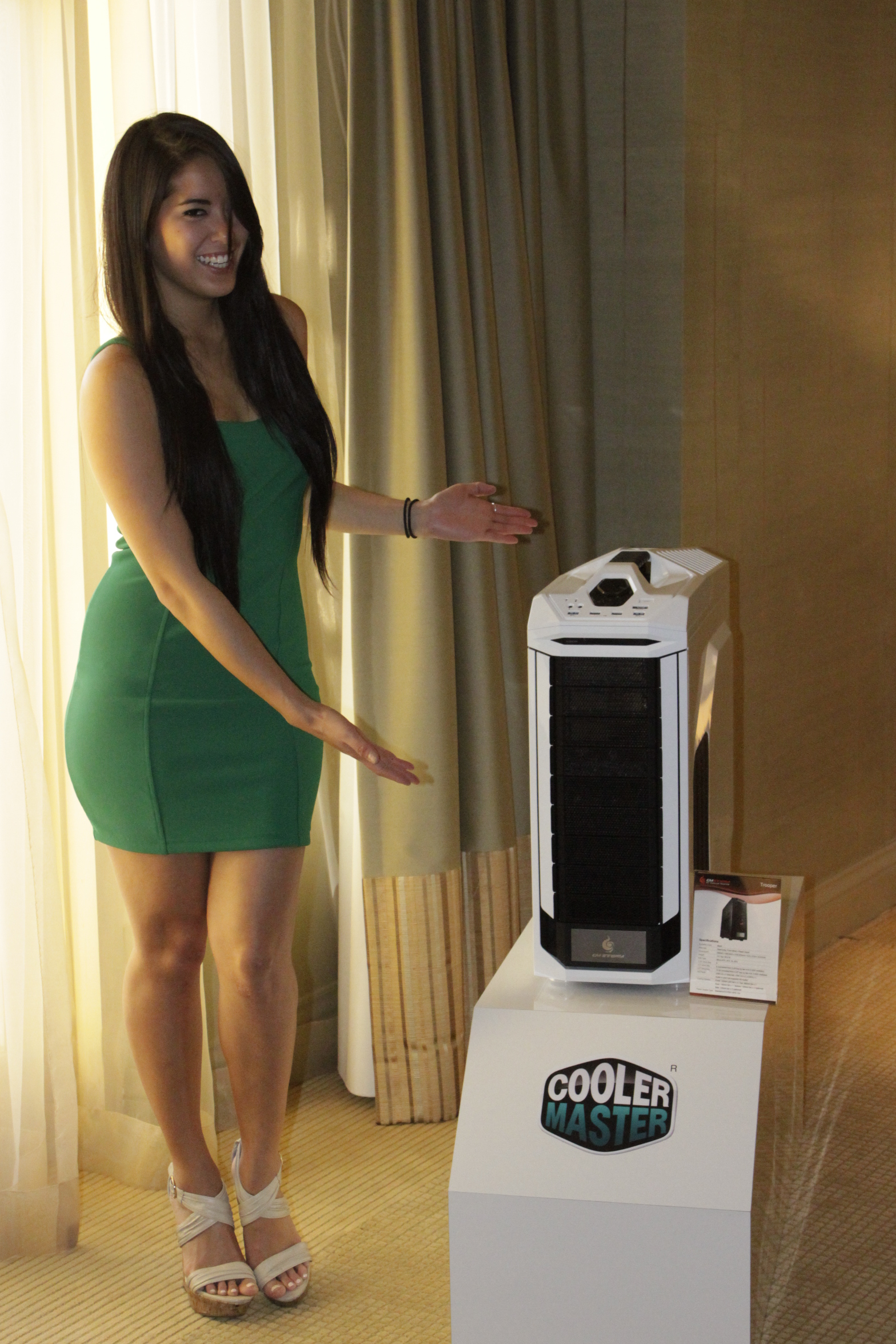 |




